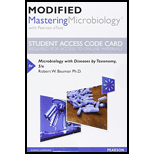
Concept explainers
(a)
To determine:
The similarities and dissimilarities in the following related terms mitosis and meiosis.
Introduction:
Mitotic cell division is a type of division in which two daughter cells are formed each having the same number and same type of chromosome as the original. Meiosis is also a type of cell division that results in the production of four daughter cells with half the number of chromosome
(b)
To determine:
The similarities and dissimilarities in the following related terms chromatids and chromosome.
Introduction:
Both chromatids and chromosome are the structures that carry hereditary information from parental generation to their next generation. Both chromatids and chromosome play important role in cell division.
(c)
To determine:
The similarities and dissimilarities in the following related terms hypha and mycelium.
Introduction:
Hyphae and mycelium both the structure are present in
(d)
To determine:
The similarities and dissimilarities in the following related terms algal body and fungal body.
Introduction:
Algae are a simple eukaryotic organism that possesses chlorophyll that acts as a primary photosynthetic pigment. Fungi are the member of a eukaryotic organism that can digest food from outside and absorbs the nutrients through its cell wall.
(e)
To determine:
The similarities and dissimilarities in the following related terms water mold and slime mold.
Introduction:
Mold is the term that is used to refer to those fungi that are multicellular and have thread-like structures called hyphae
Want to see the full answer?
Check out a sample textbook solution
Chapter 12 Solutions
Modified Mastering Microbiology with Pearson eText -- Standalone Access Card -- for Microbiology with Diseases by Taxonomy (5th Edition)
- Which of the following is an example of fungus-like protist? Group of answer choices golden algae rhizopus plasmodial slime molds trufflesarrow_forwardDescribe (by tabulating), draw (or copy image) and label the four types of protozoans Flagellates Ciliatesarrow_forwardThe most complex cells are found in ___. fungi protozoa plants bacteriaarrow_forward
- Endosymbiosis greatly altered eukaryotes as they acquired organelles. In the red algae shown below, the mitochondria is on left (solid lines), the chloroplast is in the middle (dotted lines), and the nucleus is on the right (dashed lines).arrow_forwardWhich group of organisms do not have microtubules inside their cells? Ciliophora Archaeozoa Apicomoplexa Microsporidiaarrow_forwardMatch the following questions about Eukaryotic microorganisms to the "BEST" possible answer... A. Spore forming which often make unseptate hyphae B. Spore forming which often make septate hyphae and reproduce sexually C. Lack mitochondria and flagella but form cysts and possess mitosomes D. Spore forming and possess mitochondria as well as flagella E. Spore forming which often make septate hyphae and reproduce asexually F. Intercellular and intracellular organisms with common clamp connections G. Intercellular organisms with rare clamp connections H. Cyst forming and possess mitochondria as well as flagella I. Spore forming which often make unseptate mycelium J. Lack mitochondria and flagella but form spores and possess mitosomes 1. Microsporidia 2. Chytridiomycota 3. Zygomycota or Mucorales 4. Glomeromycota 5. Ascomycota 6. Basidiomycota 7. Pucciniales or Uredinales 8. Ustilaginomycetes 9. Giardia intestinalis 10. Dinoflagellatearrow_forward
- List two protists that are ciliates or flagellates List two protists that are amoeboid list two organisms that cause diseas and what diseases they cause create a pie chart or bar graph comparing the forms of motilityciliates, flagellates and amoebaarrow_forwardWhich of the following organisms is an example of fungus-like protist? Group of answer choices water molds rhizopus truffles golden algaearrow_forwardWhich species causes the waterborne disease giardiasis? euglenoids trypanosomes diplomonads parabasalids any anaerobic protozoans Previousarrow_forward
- Compare and contrast the two types of slime molds with one another and with water molds.arrow_forwardMatch the statement with the group – animals, plants, fungi, or a combination. Mitosis forms spores Answer 1- Choose...(animals only), (animals and fungi), (animals, plants, and fungi),(animals and plants), (fungi only), (plants and fungi), (plants only) - same options for all bellow...... Zygote undergoes mitosis Answer 2Choose....(animals only), (animals and fungi), (animals, plants, and fungi),(animals and plants), (fungi only), (plants and fungi), (plants only) Haploid dominant Answer 3Choose....(animals only), (animals and fungi), (animals, plants, and fungi),(animals and plants), (fungi only), (plants and fungi), (plants only) Meiosis forms gametes Answer 4Choose....(animals only), (animals and fungi), (animals, plants, and fungi),(animals and plants), (fungi only), (plants and fungi), (plants only) Diploid dominant Answer 5 Choose....(animals only), (animals and fungi), (animals, plants, and fungi),(animals and plants), (fungi only), (plants and fungi),…arrow_forwardGive one significant difference between Protista and Fungi.arrow_forward
 Biology Today and Tomorrow without Physiology (Mi...BiologyISBN:9781305117396Author:Cecie Starr, Christine Evers, Lisa StarrPublisher:Cengage Learning
Biology Today and Tomorrow without Physiology (Mi...BiologyISBN:9781305117396Author:Cecie Starr, Christine Evers, Lisa StarrPublisher:Cengage Learning
